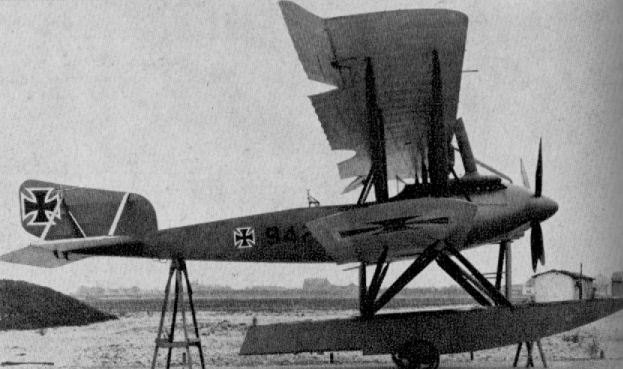K.W. (Kaiserliche Werften) Type 947
O.Thetford, P.Gray German Aircraft of the First World War (Putnam)
K.W.
Various two-seater seaplanes were designed and built in ones and twos by the Imperial Naval Yards (Kaiserlicht Werft) as follows: Danzig: Nos. 404-405, 467-470, 1105-1106 and 1650. Kiel: Nos. 463-466. Wilhelmshafen: Nos. 401-403, 461-462, 945 and 947.
Data on Nos. 1105-1106: Engine, 150 h.p. Benz III. Span, 14.1 m. (46 ft. 3 1/4 in.). Length, 8.85 m. (29 ft. 0 3/8 in.). Height, 3.725 m. (12 ft. 2 5/8 in.).
J.Herris German Seaplanes of WWI (A Centennial Perspective on Great War Airplanes 15)
Kaiserliche Werften Type 947
The only Kaiserliche Werften Type 947 was built at Kaiserliche Werft Wilhelmshaven. The Type 947 was an armed, two-seat reconnaissance floatplane, naval category CHFT, powered by a 220 hp Mercedes D.IV straight-eight engine.
Category CHFT meant the aircraft had a flexible gun for the observer and was fitted with a wireless transmitter and receiver.
The Type 947 was ordered in August 1916. Production of the six-cylinder, 260 hp Mercedes D.IVa was in its very early stages so the most powerful engine available was the eight-cylinder, 220 hp Mercedes D.IV. A four-blade propeller was used instead of a two-blade propeller so the individual blades would be shorter, providing good clearance from the water while enabling shorter struts for the floats.
The Type 947 was evaluated by the SVK at Warnemunde but was not accepted and was returned to the manufacturer on December 17, 1917. SVK records stop at the end of June 1918, so the final disposition of the Type 947 is unknown.
Kaiserliche Werften Type 947 Specifications
Engine: 220 hp Mercedes D.IV
Wing: Span 15.95 m
General: Length 13.0 m
Height 4.00 m
Kaiserliche Werften Type 1650
The sole Kaiserliche Werften Type 1650 floatplane was built at KW Danzig. Ordered in June 1917, it was the last floatplane ordered from the Kaiserliche Werften. The listing of German seaplane numbers shows it as a category CHFT, meaning the aircraft had a flexible gun for the observer and was fitted with a wireless transmitter and receiver.
By the time the Type 1650 was ordered, the 260 hp Mercedes D.IVa six-cylinder engine was well-established in production. Despite that, the Type 1650 was powered by a straight-eight 220 hp Mercedes D.IV that was then obsolescent and out of production. The straight-eight was not only less powerful than its six-cylinder replacement, it was also less reliable. Crankshaft failures of the long engine were a problem, although much less so in single-engine aircraft than in multi-engine aircraft.
The most likely reason the older, less reliable engine was used is that it was available; most of the few production aircraft using this engine had been retired from the front by the time the Type 1650 was ordered, releasing some engines for other use. The more powerful and reliable Mercedes D.IVa engine that replaced the straight-eight in production was in great demand for G-type bombers and the more powerful C-type reconnaissance airplanes. The Type 1650 had a much lower priority than these vital types and so had to make due with the older engine.
The SVK records are incomplete so the delivery date of the Type 1650; indeed whether it was completed or delivered at all is not known. The list of German seaplane number notes that it was cancelled and there is no SVK drawing of the type.
Kaiserliche Werften Type 1650 Specifications
Engine: 220 hp Mercedes D.IV



